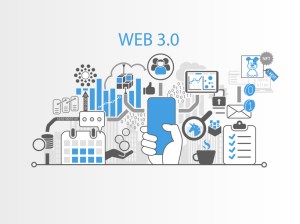The first iteration of the Web transformed business as we know it offering companies of every size a way to promote themselves to anyone, anywhere, at any time.
Next came Web 2.0, where technology advanced to support more user-generated content and interactive features.
Web 3.0 opens up a new wave of opportunities, and it’s important to understand what they are and how to pursue them.
What is Web 3.0?
The rise of the term “Web 3.0” doesn’t mean online experiences as we know them are necessarily going away. Much like other transitions in technology, it’s best to think of Web 3.0 as an evolution in how businesses operate on the Internet – where everyday users could have a lot more control.
The underlying foundation for Web 3.0 is a technology known as blockchain, which allows data to be decentralized and transactions recorded on a sort of shared digital ledger. This happens across many computers, which means it is easier to verify transactions and difficult to make changes to records independently.
What this means, in simple terms, is that people using the Web 3.0 could do so without having to work with intermediary services from a large tech company like a search engine or social media service. Instead, decentralized applications could be governed more directly by the people who use them, and areas like privacy could be strengthened.
The full definition of Web 3.0 is still something of a work in progress, through. The most common use of blockchain has been in transactions involving cryptocurrencies such as Bitcoin, but that’s just the beginning. The same technology can support a wide range of decentralized applications, including contracts that “execute” their terms by themselves to more targeted forms of advertising.
The need to begin planning for Web 3.0 now
Canadian small and medium-sized businesses (SMBs) could benefit from Web 3.0 technologies in a number of ways, including an ability to develop more innovative customer experiences. If you’re tempted to sit on the sidelines while it all comes together, here’s a word of advice: Don’t.
Unlike previous iterations of the web, companies that are quick to harness the power of Web 3.0 could gain a competitive advantage over others in their industry. In fact, the eighth edition of Salesforce’s State of Marketing report suggested it could be a means to grapple with the challenges brought on by the deprecation of third-party data services.
“For the 46 per cent of marketers who don’t yet have a Web3 strategy, unique digital assets like cryptocurrency, the metaverse, and nonfungible tokens (NFTs) could present new opportunities for brands to collect first-party data as the end of the cookie nears,” the report said.
If you’re not sure how to get started with Web 3.0, you’re probably not alone. Fortunately, the best approach follows the same kind of strategic thinking that has always defined the most successful SMBs:
1. Tap into trusted sources of insights and expertise
Your business may not be on the cutting edge of Web 3.0 today, but you’re likely working close to other companies that are.
This includes vendors whose products make up your existing tech stack. Ask them for a briefing on how they see decentralized applications transforming their product roadmaps, and what it will mean for companies like yours.
You can also reach out to partners, suppliers, and even some of your best customers to see where they’re exploring or applying Web 3.0 in the short and long term. This is a great way to benchmark yourself against other companies and inform a more tailored strategy for your business.
2. Reimagine what ‘customer experience’ could mean in a Web 3.0 world
You’ll never go wrong by walking a mile in your customer’s shoes, even if few of them have begun the journey to Web 3.0 yet.
Consider a day in their lives and, based on what you learn about Web 3.0, how the way they spend their time might change. How could Web 3.0 offer more use cases for technologies like augmented reality (AR), for example? Where might the use of Web 3.0 lead to more dynamic peer-to-peer interactions within communities of customers? Could you create NFTs that integrate some kind of value to change the way you reward customer loyalty?
Don’t forget what Web 3.0 means for the work that happens behind the scenes to deliver these experiences. Your strategy should think about the impact on employee journeys as well as customer experiences.
3. Evaluate the connection between Web 3.0 and your most important KPIs
One thing that doesn’t change with Web 3.0 is the old adage that you can’t manage what you don’t measure.
Think about your biggest business goals and the key performance indicators (KPIs) you’re using to track your progress today. These could include customer acquisition cost, churn, Net Promoter Score (NPS) or customer satisfaction (CSAT).
Your strategy for incorporating Web 3.0 technologies could contribute positively to these sorts of KPIs. This means not only thinking about the products you’ll adopt or the applications you’ll develop. You’ll also have to consider business process changes that will happen and ensure your team will see gains in areas from productivity to collaboration and efficiency.
You may not be ready to have your business develop a defined Web 3.0 strategy. Instead, you might simply pick and choose decentralized applications and related technologies as a way to support or build upon your existing strategy.
We’ll all likely be living in a Web 3.0 before you know it – which is why it’s a good idea to begin thinking about how this next iteration of online experiences could fuel your future growth.

























